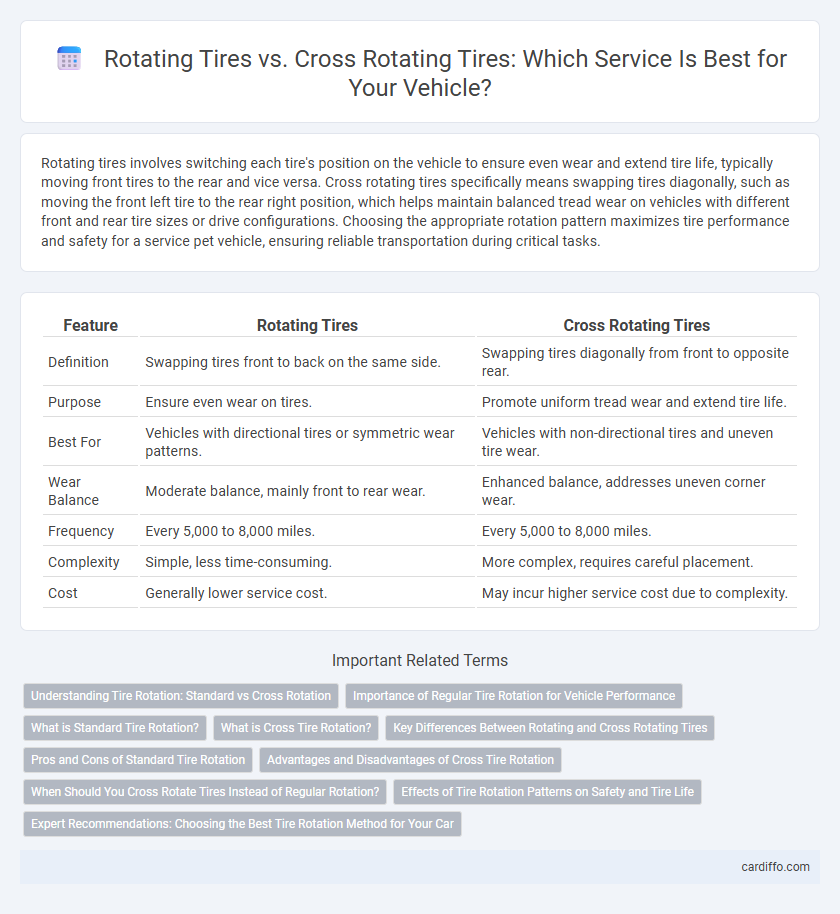Rotating tires involves switching each tire's position on the vehicle to ensure even wear and extend tire life, typically moving front tires to the rear and vice versa. Cross rotating tires specifically means swapping tires diagonally, such as moving the front left tire to the rear right position, which helps maintain balanced tread wear on vehicles with different front and rear tire sizes or drive configurations. Choosing the appropriate rotation pattern maximizes tire performance and safety for a service pet vehicle, ensuring reliable transportation during critical tasks.
Table of Comparison
| Feature | Rotating Tires | Cross Rotating Tires |
|---|---|---|
| Definition | Swapping tires front to back on the same side. | Swapping tires diagonally from front to opposite rear. |
| Purpose | Ensure even wear on tires. | Promote uniform tread wear and extend tire life. |
| Best For | Vehicles with directional tires or symmetric wear patterns. | Vehicles with non-directional tires and uneven tire wear. |
| Wear Balance | Moderate balance, mainly front to rear wear. | Enhanced balance, addresses uneven corner wear. |
| Frequency | Every 5,000 to 8,000 miles. | Every 5,000 to 8,000 miles. |
| Complexity | Simple, less time-consuming. | More complex, requires careful placement. |
| Cost | Generally lower service cost. | May incur higher service cost due to complexity. |
Understanding Tire Rotation: Standard vs Cross Rotation
Understanding tire rotation involves recognizing the difference between standard and cross rotation patterns to maximize tire lifespan and ensure even tread wear. Standard rotation moves tires front-to-back on the same side, suitable for directional tires, while cross rotation shifts tires diagonally, optimizing wear on non-directional tires by balancing load and traction. Proper rotation scheduling, typically every 5,000 to 7,500 miles, enhances vehicle handling and prevents premature tire replacement.
Importance of Regular Tire Rotation for Vehicle Performance
Regular tire rotation is crucial for maintaining even tread wear, prolonging tire life, and ensuring optimal vehicle handling. Cross rotating tires, which involves moving tires diagonally between axles, helps balance tire wear more effectively on front-wheel or all-wheel-drive vehicles. Maintaining a consistent rotation schedule of every 6,000 to 8,000 miles supports fuel efficiency and enhances overall driving safety.
What is Standard Tire Rotation?
Standard tire rotation involves moving tires in a specific pattern to ensure even tread wear and extend tire life. Commonly, front tires are swapped with rear tires on the same side, maintaining their original positions. This method balances wear patterns caused by different driving forces on the front and rear axles.
What is Cross Tire Rotation?
Cross tire rotation is a tire maintenance technique where the front tires are moved to the rear on the opposite sides, while the rear tires are moved straight to the front on the same side. This method helps even out tire wear by balancing the tread life across all tires, improving vehicle handling and extending tire longevity. It is especially beneficial for vehicles with front-wheel drive, where front tires tend to wear faster than rear tires.
Key Differences Between Rotating and Cross Rotating Tires
Rotating tires involves moving each tire to a different position on the same side of the vehicle, typically front to rear, to ensure even tire wear and extended lifespan. Cross rotating tires swaps tires diagonally, such as moving the front right tire to the rear left position, balancing wear patterns more effectively on vehicles with uneven weight distribution or directional tread patterns. Understanding key differences helps optimize tire performance, enhance safety, and reduce replacement costs.
Pros and Cons of Standard Tire Rotation
Standard tire rotation extends tire lifespan by ensuring even wear across all tires, improving overall vehicle handling and safety. It typically involves swapping front tires with rear ones on the same side, simplifying the process and saving time during routine maintenance. However, this method may not address uneven wear patterns caused by drivetrain types or wheel alignment issues as effectively as cross rotation.
Advantages and Disadvantages of Cross Tire Rotation
Cross tire rotation improves even tire wear by alternating front and rear tires diagonally, extending overall tire lifespan and enhancing vehicle handling. This method balances tread wear on unevenly worn tires, reducing road noise and improving traction consistency. However, cross rotation may not be suitable for directional or staggered tires, and it can require more careful alignment checks to prevent uneven wear patterns.
When Should You Cross Rotate Tires Instead of Regular Rotation?
Cross rotating tires is recommended when uneven tire wear patterns emerge, such as on vehicles with front or rear-wheel drive, to promote balanced tread wear and extend tire lifespan. It is especially beneficial for directional tires or when the front and rear tires differ in size, as cross rotation helps maintain traction and handling performance. Regular rotation suits vehicles with uniform tire sizes and wear but lacks the wear equalization achieved through cross rotation when drivetrain demands differ.
Effects of Tire Rotation Patterns on Safety and Tire Life
Rotating tires using a cross rotation pattern redistributes wear more evenly across all four tires, enhancing overall tread life and maintaining balanced traction for improved safety. Standard front-to-back rotation may extend tire longevity but can result in uneven wear on drive tires, potentially compromising handling on slippery surfaces. Proper rotation patterns tailored to tire type and drivetrain maximize grip, reduce risk of blowouts, and promote consistent vehicle stability.
Expert Recommendations: Choosing the Best Tire Rotation Method for Your Car
Expert recommendations emphasize choosing tire rotation methods based on vehicle type and tire wear patterns to maximize tire lifespan and performance. Cross rotating tires, which involve switching tires diagonally, is preferred for front-wheel-drive vehicles to promote even wear and improve handling. For all-wheel or rear-wheel drive cars, straight rotation is often advised to maintain consistent tread wear and extend tire durability.
rotating tires vs cross rotating tires Infographic

 cardiffo.com
cardiffo.com